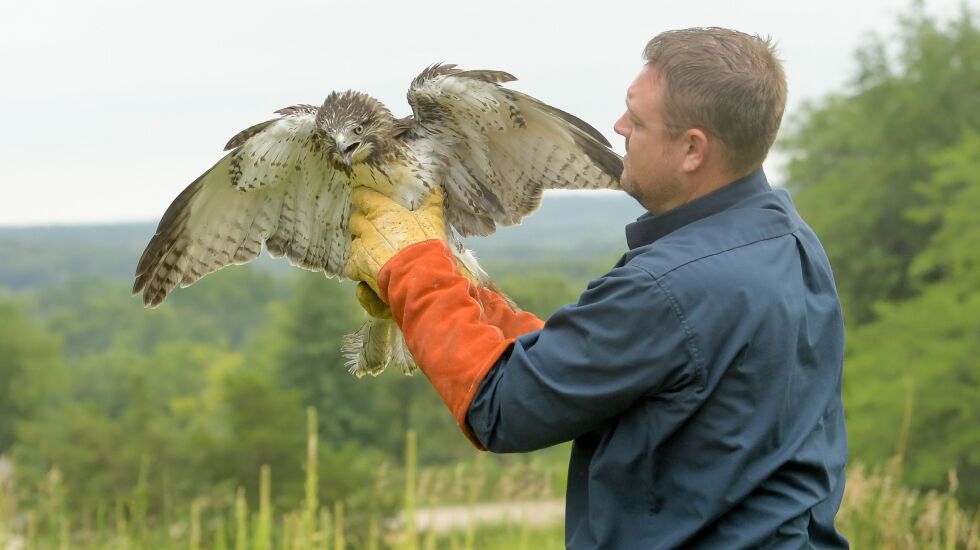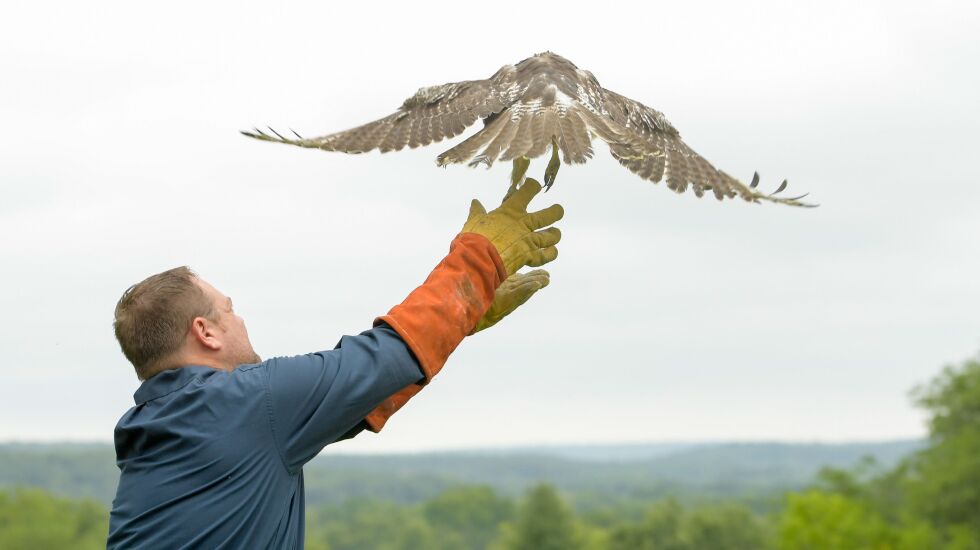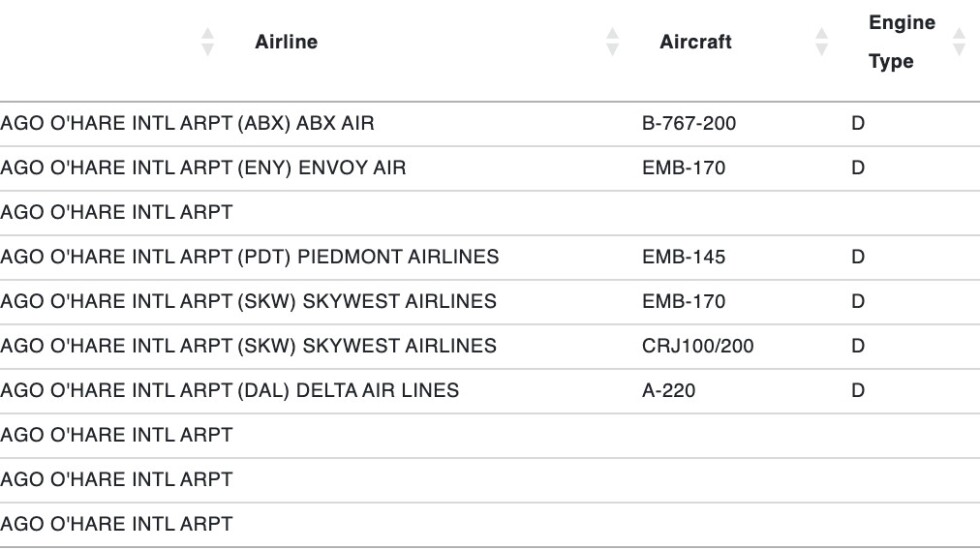
O’Hare Airport is a busy place in the obvious ways — with more than 68 million travelers and 711,000 flights in 2022. But there’s also a staggering amount of other activity beyond the terminals and outside of public view.
O’Hare’s grassy grounds teem with wild animals. To keep those animals from causing potentially catastrophic conflicts with jetliners, a team of wildlife specialists captures, disperses or euthanizes tens of thousands of the creatures every year.
Mostly, they’re encountering birds, from raptors such as bald eagles and the occasional snowy owl to far more common varieties, including geese, ducks and blackbirds.

The busy airport also is home to deer, coyotes, foxes, skunks and even beavers.
In all, 21,112 wild animals caught at O’Hare were euthanized between Oct. 1, 2021, and Sept. 30, 2022 — the most recent data available from the U.S. Department of Agriculture’s wildlife services division.
During that period, 18,618 animals were shooed or scared away, sometimes with workers driving a vehicle near them, sometimes with a gun blast, sometimes by using pyrotechnics that “cause a bang and startle the birds.”
“We are at hundreds of airports nationwide for the safety of planes and people,” says Tanya Espinosa, a USDA spokeswoman. “Our role at airports is to assist in wildlife management to ensure the safety of people and aircraft.”
Keeping away birds “also helps protect the birds,” Espinosa says. “Birds are not going to do well with a bird-airplane collision. That’s one they’re going to lose.”
“If we can disturb them enough to roost somewhere else or hunt somewhere else . . . it’s better for people and for the creatures themselves.”

There have been more than 100 incidents this year in which birds are believed to have collided with planes at or near O’Hare, according to a database from the Federal Aviation Administration, which regulates U.S. airports and airspace. Some of the damage caused was substantial, though the records don’t get into detail.
Last fall, a jetliner and bird collided shortly after takeoff from O’Hare. The plane ended up circling back and safely landing amid reports of flames shooting from an engine.
During that same fiscal year 2022 time frame, 155 birds were captured at O’Hare and relocated, including 74 falcons and 65 red-tailed hawks.

In 2021, there were 156 birds relocated. In 2020, there were 361.
O’Hare has five USDA wildlife biologists and biological science technicians providing “wildlife hazard management assistance.”
Earlier this month, a red-tailed hawk was captured at the airport, which encompasses roughly 7,200 acres, and transferred to public land in western Illinois, and the Chicago Sun-Times was allowed to photograph the release as long as the exact location wasn’t disclosed.
“Only raptors are relocated” from O’Hare, Espinosa says. “So falcons, hawks, definitely eagles, sometimes owls — anything endangered or threatened.
“Even if there’s a substantial population in that state, we’ll relocate. It’s harder, for example, to relocate black birds because they are in a flock, not to mention the population of black birds is incredibly large, so there’s no concern or worry that it might cause a potential issue with the population.
“Relocation sites must have suitable habitat for raptors and landowner approval. Raptors are generally relocated to wildlife management areas and parks.

“We’re always looking for nonlethal ways,” Espinosa says. “But there are times a nonlethal method is not going to work, whether it’s a bird that consistently refuses to leave or one that’s decided that this roost is going to be great.
“The potential to relocate an animal and potentially spread a wildlife disease and the likelihood that the wild animal may return” to O’Hare “or another airfield are two factors that are used to assess whether an animal can be relocated or needs to be euthanized,” she says.
The vast majority of the animals that are put down and “dispersed” are European starlings, an invasive species, according to records that show 19,870 were euthanized and 11,206 were shooed away in fiscal year 2022.

The USDA records also show 20 coyotes and two red foxes were shot and killed at O’Hare during the same period. Guns are among the methods wildlife officials use for putting down animals there, along with poisonous gas.
Illinois law dictates that captured coyotes and foxes “must be released alive or euthanized,” according to the Illinois Department of Natural Resources.
The federal records also show:
- Eight great egrets — described by one group of experts as a “long-legged wading bird with a long, S-curved neck and a dagger-like bill” — were euthanized with guns, while another 322 were dispersed.
- One hundred and 24 Canada geese were shot and killed. Another 1,661 were chased off. Though such migratory birds are federally protected, the USDA is allowed to euthanize a certain number each year under a permit.
- Two hundred and 68 red-winged blackbirds, known for their sometimes-aggressive temperament and low-to-the-ground nesting, were euthanized, mostly after being caught in traps.
- Six bald eagles were shooed away with special explosives, 35 were shooed away the previous year and 44 in 2020.
- Seven snowy owls were captured in traps and relocated this past year, and 86 were dispersed.
- Two beavers were euthanized with a gun, and five beaver dams were removed.
There are four main creeks at O’Hare, all tributaries to the Des Plaines River, according to the Chicago Department of Aviation, the city agency that operates O’Hare. Roughly “half of O’Hare’s 7,200 acres is either pavement or facilities. The other half is mostly managed and mowed green space, and about 100 acres is shrubbed or forested,” department spokesman Kevin Bargnes says.
“O’Hare is one of the few airports in the country that has invested in a perimeter fence with a buried skirt, which prevents wildlife from digging to enter the airfield,” Bargnes says, and officials closely monitor “both food and water sources on O’Hare property, which helps to keep wildlife away.”







